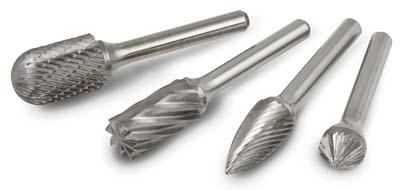
CGW-Camel Grinding Wheels offers a full line of USA-made carbide burs for metal working.
Manufactured on premium automated CNC machines, CGW's carbide burs are available in three main styles of cuts: single, double and aluminum. Single-cut burs are for general-purpose work and provide good material removal. Double-cut burs produce smaller chips for greater operator control on applications such as stainless steels and ferrous materials. Aluminum-cut burs have a wide flute design for easy stock removal without loading on applications such as nonferrous and soft materials.
"CGW carbide burs are a versatile, high-quality metal working tool," said Joe O Mera, president, CGW-Camel Grinding Wheels.
The carbide bur line includes more than 175 individual burs and one 8-piece kit. Overall bur lengths range from 1 ½- to 7-inches and include popular SA, SC and SG head shapes. CGW's carbide burs are used in many industries including automotive, aerospace, foundry, power station and engineering for mold and pattern making, die sinking, tool making and maintenance.
Contact Details
Related Glossary Terms
- bur
bur
Tool-condition problem characterized by the adhesion of small particles of workpiece material to the cutting edge during chip removal.
- computer numerical control ( CNC)
computer numerical control ( CNC)
Microprocessor-based controller dedicated to a machine tool that permits the creation or modification of parts. Programmed numerical control activates the machine’s servos and spindle drives and controls the various machining operations. See DNC, direct numerical control; NC, numerical control.
- grinding
grinding
Machining operation in which material is removed from the workpiece by a powered abrasive wheel, stone, belt, paste, sheet, compound, slurry, etc. Takes various forms: surface grinding (creates flat and/or squared surfaces); cylindrical grinding (for external cylindrical and tapered shapes, fillets, undercuts, etc.); centerless grinding; chamfering; thread and form grinding; tool and cutter grinding; offhand grinding; lapping and polishing (grinding with extremely fine grits to create ultrasmooth surfaces); honing; and disc grinding.
- stainless steels
stainless steels
Stainless steels possess high strength, heat resistance, excellent workability and erosion resistance. Four general classes have been developed to cover a range of mechanical and physical properties for particular applications. The four classes are: the austenitic types of the chromium-nickel-manganese 200 series and the chromium-nickel 300 series; the martensitic types of the chromium, hardenable 400 series; the chromium, nonhardenable 400-series ferritic types; and the precipitation-hardening type of chromium-nickel alloys with additional elements that are hardenable by solution treating and aging.
